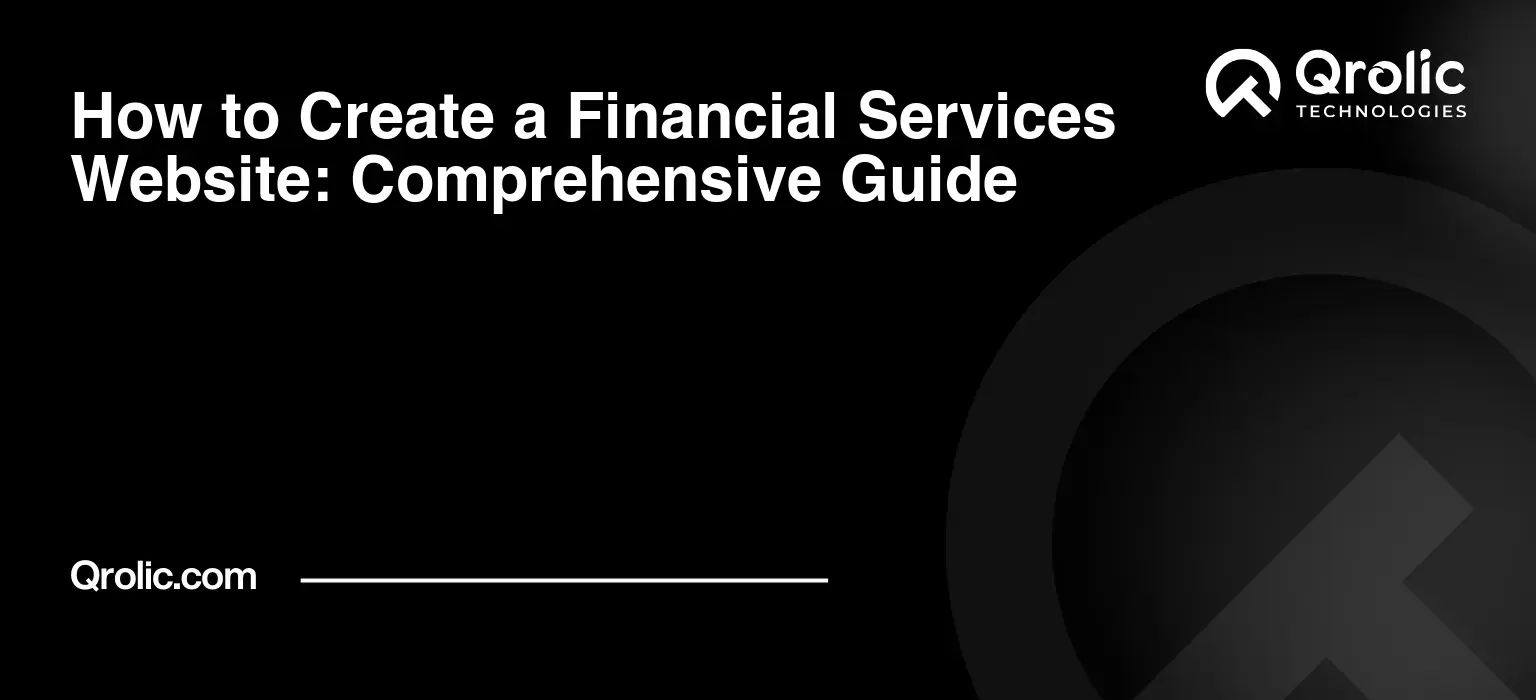Quick Summary:
- Your website is essential for first impressions and leads.
- Focus on user-friendly design and valuable content.
- Optimize your site for search and track results.
- Invest in professional design for better growth.
Table of Contents
- Why Your Website is Your Most Valuable Asset
- The Digital Front Door: First Impressions Matter
- The Power of Online Visibility: Reaching a Wider Audience
- Establishing Credibility and Expertise: Building Trust
- Generating Leads and Converting Prospects: Turning Visitors into Clients
- Providing Value and Education: Serving Your Audience
- The Essential Elements of a High-Converting Financial Advisor Website
- 1. Understanding Your Target Audience
- 2. Defining Your Brand Identity
- 3. User-Friendly Navigation and Design
- 4. Compelling Content: Engaging and Informative
- 5. Strategic Calls to Action
- 6. Search Engine Optimization (SEO)
- 7. Analytics and Tracking
- Key Pages Every Financial Advisor Website Needs
- Homepage
- About Us
- Services
- Resources
- Contact Us
- Blog
- Avoiding Common Website Design Mistakes
- 1. Using Jargon and Technical Terms
- 2. Focusing on Yourself Instead of Your Clients
- 3. Ignoring Mobile Users
- 4. Neglecting SEO
- 5. Not Tracking Your Results
- 6. Generic Stock Photos
- 7. Ignoring Website Accessibility
- The Investment in Professional Financial Advisor Website Design
- Qrolic Technologies: Your Partner in Financial Advisor Website Design
- Why Choose Qrolic Technologies?
- Our Process
- The Future of Financial Advisor Websites: Trends to Watch
- Personalization
- Artificial Intelligence (AI)
- Video Marketing
- Interactive Content
- Voice Search Optimization
- Building a Website That Works for You
Why Your Website is Your Most Valuable Asset

In today’s digital age, your website is often the first (and sometimes only) impression you make on potential clients. It’s your 24/7 virtual office, a crucial tool for attracting, engaging, and converting leads into loyal clients. For financial advisors, a professionally designed website isn’t just a nice-to-have; it’s a non-negotiable necessity for thriving in a competitive landscape. Why?
The Digital Front Door: First Impressions Matter
Think of your website as the digital equivalent of your physical office. Would you meet a potential client in a cluttered, outdated space? Of course not! Your website needs to exude professionalism, competence, and trustworthiness from the moment a visitor lands on your homepage. A poorly designed website can instantly damage your credibility, sending potential clients running to your competitors.
The Power of Online Visibility: Reaching a Wider Audience
Traditional marketing methods like print ads and networking events have their place, but they pale in comparison to the reach and cost-effectiveness of a well-optimized website. A strong online presence allows you to reach a geographically diverse audience, connecting with individuals who are actively searching for financial advice.
Establishing Credibility and Expertise: Building Trust
Your website is your opportunity to showcase your expertise, credentials, and track record. Through informative content, client testimonials, and compelling case studies, you can build trust and establish yourself as a knowledgeable and reliable financial advisor.
Generating Leads and Converting Prospects: Turning Visitors into Clients
A strategically designed website isn’t just a passive online brochure; it’s a powerful lead generation tool. By incorporating clear calls to action, lead capture forms, and engaging content, you can guide visitors through the sales funnel and convert them into paying clients.
Providing Value and Education: Serving Your Audience
A helpful, informative website positions you as a valuable resource for potential and existing clients. By providing educational content, financial calculators, and helpful resources, you can demonstrate your commitment to serving your audience and building long-term relationships.
The Essential Elements of a High-Converting Financial Advisor Website

Creating a successful website for financial advisors requires more than just slapping together a few pages with some stock photos. You need a strategic approach that considers your target audience, your brand identity, and your business goals. Here are the essential elements to focus on:
1. Understanding Your Target Audience
- Who are you trying to reach? Before you start designing your website, you need to clearly define your target audience. Are you targeting high-net-worth individuals, young professionals, or retirees? Understanding their demographics, financial goals, and pain points will help you tailor your website’s content and design to resonate with them.
- What are their needs and concerns? What are the key questions and concerns that your target audience has about financial planning? Address these concerns directly on your website, providing valuable insights and solutions.
- What are they searching for online? Conduct keyword research to identify the terms and phrases that your target audience is using to search for financial advice online. Incorporate these keywords into your website’s content and meta descriptions to improve your search engine rankings.
2. Defining Your Brand Identity
- What is your unique selling proposition (USP)? What makes you different from other financial advisors? Clearly communicate your USP on your website, highlighting your unique skills, experience, and approach.
- What is your brand personality? Is your brand professional and conservative, or more approachable and friendly? Your website’s design, tone of voice, and imagery should reflect your brand personality.
- What are your brand values? What values are important to your firm? Integrity, transparency, and client focus? Communicate these values clearly on your website.
3. User-Friendly Navigation and Design
- Intuitive navigation: Ensure that your website is easy to navigate, with a clear and logical structure. Use a simple menu system and clear calls to action to guide visitors to the information they need.
- Mobile-responsive design: With the majority of internet users accessing websites on mobile devices, it’s crucial that your website is mobile-responsive. This means that it adapts seamlessly to different screen sizes, providing a consistent user experience across all devices.
- Clean and modern design: Avoid clutter and visual distractions. Use a clean and modern design with plenty of white space to improve readability and create a professional impression.
- Fast loading speed: Website speed is a critical factor for user experience and search engine rankings. Optimize your images, minimize code, and use a reliable hosting provider to ensure that your website loads quickly.
4. Compelling Content: Engaging and Informative
- Clear and concise messaging: Avoid jargon and technical terms that your target audience may not understand. Use clear and concise language to communicate your value proposition and services.
- Value-driven content: Focus on providing valuable content that addresses your target audience’s needs and concerns. This could include blog posts, articles, infographics, and videos.
- Client testimonials and case studies: Social proof is a powerful tool for building trust. Include client testimonials and case studies to showcase your success and demonstrate the value you provide.
- Regularly updated content: Keep your website fresh and engaging by regularly updating your content. This will not only improve your search engine rankings but also keep visitors coming back for more.
5. Strategic Calls to Action
- Clear and prominent calls to action: Guide visitors to take the next step by using clear and prominent calls to action. Examples include “Schedule a Consultation,” “Download Our Free Guide,” or “Contact Us Today.”
- Placement of calls to action: Strategically place calls to action throughout your website, including on your homepage, service pages, and blog posts.
- A/B testing: Experiment with different calls to action to see which ones perform best. Track your results and make adjustments as needed.
6. Search Engine Optimization (SEO)
- Keyword research: Identify the keywords that your target audience is using to search for financial advice online.
- On-page optimization: Optimize your website’s content, meta descriptions, and title tags with relevant keywords.
- Off-page optimization: Build backlinks from other reputable websites to improve your website’s authority and search engine rankings.
- Local SEO: Optimize your website for local search to attract clients in your geographic area. This includes claiming your Google My Business listing and building citations on local directories.
7. Analytics and Tracking
- Google Analytics: Track your website’s traffic, user behavior, and conversion rates using Google Analytics.
- Conversion tracking: Set up conversion tracking to measure the effectiveness of your calls to action and lead generation efforts.
- Regular monitoring: Regularly monitor your website’s analytics to identify areas for improvement and optimize your website’s performance.
Key Pages Every Financial Advisor Website Needs

While the specific pages you include on your website will depend on your business and target audience, here are some essential pages that every financial advisor website should have:
Homepage
- Purpose: To make a strong first impression, clearly communicate your value proposition, and guide visitors to the information they need.
- Key elements: Compelling headline, clear and concise messaging, high-quality visuals, prominent calls to action, and easy navigation.
About Us
- Purpose: To introduce your team, showcase your expertise, and build trust with potential clients.
- Key elements: Photos of your team members, biographies highlighting their experience and qualifications, your firm’s mission statement, and your brand values.
Services
- Purpose: To clearly explain the services you offer and how they can benefit your clients.
- Key elements: Detailed descriptions of each service, pricing information (if applicable), client testimonials, and calls to action to schedule a consultation.
Resources
- Purpose: To provide valuable information and resources to your target audience, positioning you as a trusted advisor.
- Key elements: Blog posts, articles, infographics, videos, financial calculators, and downloadable guides.
Contact Us
- Purpose: To make it easy for potential clients to get in touch with you.
- Key elements: Contact form, phone number, email address, physical address (if applicable), and social media links.
Blog
- Purpose: To provide regular, valuable content that attracts and engages your target audience, improves your search engine rankings, and establishes you as a thought leader.
- Key elements: High-quality articles on relevant financial topics, engaging visuals, and clear calls to action.
Avoiding Common Website Design Mistakes

Creating a successful website for financial advisors requires careful planning and execution. Here are some common mistakes to avoid:
1. Using Jargon and Technical Terms
- Problem: Confusing potential clients with complex financial jargon.
- Solution: Use clear and concise language that your target audience can easily understand. Avoid technical terms or explain them in plain English.
2. Focusing on Yourself Instead of Your Clients
- Problem: Talking about your accomplishments and expertise without addressing the needs and concerns of your target audience.
- Solution: Focus on the benefits you can provide to your clients and how you can help them achieve their financial goals.
3. Ignoring Mobile Users
- Problem: Providing a poor user experience for mobile users, who make up a significant portion of internet traffic.
- Solution: Ensure that your website is mobile-responsive and provides a consistent user experience across all devices.
4. Neglecting SEO
- Problem: Failing to optimize your website for search engines, making it difficult for potential clients to find you online.
- Solution: Conduct keyword research, optimize your website’s content and meta descriptions, and build backlinks from other reputable websites.
5. Not Tracking Your Results
- Problem: Failing to track your website’s traffic, user behavior, and conversion rates, making it difficult to identify areas for improvement.
- Solution: Use Google Analytics to track your website’s performance and make adjustments as needed.
6. Generic Stock Photos
- Problem: Using generic stock photos that don’t reflect your brand or resonate with your target audience can come off as insincere and untrustworthy.
- Solution: Invest in high-quality, authentic photography that showcases your team, your office, and your clients (with their permission, of course!). Real images build trust and create a more personal connection.
7. Ignoring Website Accessibility
- Problem: Websites that aren’t accessible to individuals with disabilities (visual impairments, hearing loss, etc.) alienate a significant portion of your potential audience and can even lead to legal issues.
- Solution: Design your website with accessibility in mind. Use proper color contrast, alt text for images, keyboard navigation, and ARIA attributes to ensure your site is usable by everyone. Tools like the WAVE Web Accessibility Evaluation Tool can help you identify and fix accessibility issues.
The Investment in Professional Financial Advisor Website Design

While you might be tempted to cut corners and create a website yourself or hire a cheap freelancer, investing in professional wealth management Web Development can provide a significant return on investment. A professional finance website agency brings expertise in:
- User Experience (UX) Design: Creating a seamless and intuitive user experience that guides visitors through the sales funnel.
- Visual Design: Developing a visually appealing and on-brand design that reflects your firm’s professionalism and credibility.
- Content Strategy: Crafting compelling content that resonates with your target audience and drives conversions.
- Search Engine Optimization (SEO): Optimizing your website for search engines to attract organic traffic and generate leads.
- Technical Expertise: Ensuring that your website is technically sound, secure, and optimized for performance.
Qrolic Technologies: Your Partner in Financial Advisor Website Design

At Qrolic Technologies (https://qrolic.com/), we understand the unique needs of financial advisors and wealth management firms. We specialize in creating custom website designs that attract clients, build trust, and grow your practice. Our team of experienced designers, developers, and marketing professionals will work closely with you to create a website that reflects your brand identity, showcases your expertise, and generates leads.
Why Choose Qrolic Technologies?
- Industry Expertise: We have a deep understanding of the financial services industry and the challenges that financial advisors face.
- Custom Design: We don’t use cookie-cutter templates. We create custom website designs that are tailored to your specific needs and goals.
- Results-Driven Approach: We focus on creating websites that generate leads and drive conversions.
- Ongoing Support: We provide ongoing support and maintenance to ensure that your website is always up-to-date and performing optimally.
- Comprehensive Services: From financial advisor website design to SEO and content marketing, we offer a full range of services to help you succeed online.
Our Process
- Discovery: We’ll start by learning about your business, your target audience, and your goals for your website.
- Planning: We’ll develop a detailed plan for your website, including the site structure, content strategy, and design mockups.
- Design: Our team of designers will create a visually appealing and on-brand design that reflects your firm’s professionalism and credibility.
- Development: Our team of developers will build your website using the latest technologies and best practices.
- Testing: We’ll thoroughly test your website to ensure that it’s functioning properly and provides a seamless user experience.
- Launch: Once your website is ready, we’ll launch it and provide ongoing support and maintenance.
Let Qrolic Technologies (https://qrolic.com/) help you create a website that transforms your online presence and drives your business forward. Contact us today for a free consultation.
The Future of Financial Advisor Websites: Trends to Watch

The digital landscape is constantly evolving, and financial advisors need to stay ahead of the curve to remain competitive. Here are some key trends to watch in the future of financial advisor websites:
Personalization
- Trend: Tailoring the website experience to individual visitors based on their demographics, interests, and behavior.
- Impact: Increased engagement, higher conversion rates, and improved client satisfaction.
Artificial Intelligence (AI)
- Trend: Using AI-powered chatbots to provide instant customer support, answer frequently asked questions, and generate leads.
- Impact: Improved efficiency, enhanced customer service, and increased lead generation.
Video Marketing
- Trend: Incorporating more video content into websites to engage visitors, explain complex concepts, and build trust.
- Impact: Increased engagement, improved brand awareness, and higher conversion rates.
Interactive Content
- Trend: Using interactive tools like calculators, quizzes, and assessments to engage visitors and provide personalized insights.
- Impact: Increased engagement, improved lead generation, and enhanced user experience.
Voice Search Optimization
- Trend: Optimizing websites for voice search to capture a growing segment of users who are searching for information using voice assistants like Siri and Alexa.
- Impact: Increased visibility, improved brand awareness, and higher traffic.
Building a Website That Works for You

Your website is a critical investment in the future of your financial advisory practice. By focusing on the essential elements outlined in this article, avoiding common mistakes, and staying ahead of the latest trends, you can create a website that attracts clients, builds trust, and helps you achieve your business goals. Remember to focus on your target audience, define your brand, and provide valuable content. And don’t hesitate to partner with a professional finance website agency like Qrolic Technologies (https://qrolic.com/) to ensure your website is a true asset to your business. Ultimately, successful financial advisor website design involves a blend of art, science, and a deep understanding of the financial advisory landscape.







